What is a general house heating meter and how to use it
In most cases, in high-rise residential buildings, heating is paid for using a house-wide meter, as there is no sense in setting individual ones. Anyway, the whole system is looped back, therefore, a stand-alone device is not able to determine the consumption of one consumer.
The explanation for this is quite simple and we will mention this below and tell you about what constitutes such a device. We will also talk about the methods and principles of calculation, and in addition we will show a thematic video clip.

Legal grounds
Note. In the article you will come across the abbreviation IPU and ODPU, you can also find it in the documents. IPU is an individual metering device, and PDPU is a general house metering device.
Legislation
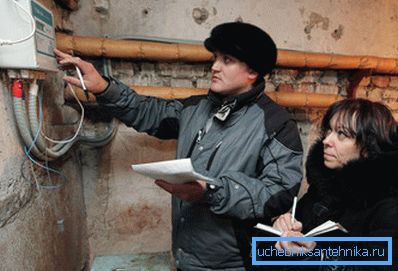
- On September 1, 2012, a Resolution of the Government of the Russian Federation came into force, which regulates the payment and calculation of heating for a household meter (document to No. 354 of May 6, 2011). In accordance with the existing Resolution, certain rules were derived, where certain positions are specified, for example, in a residential or non-residential building, in which there is no individual device.
- It implies that the amount of payment is set by local authorities, evenly distributed among residents according to the standard consumption per square meter and the frequency coefficient (duration of the heating season) in a particular region.
- This indicates that before proceeding with any calculations, you, first of all, need to find out the current order in your area. To do this, there are certain regulations with which you can familiarize yourself with the local administration.
| Availability ODPU | Type of buildings | Availability of ICS | Formula for calculating the size of the board |
| The house is not ODPU | Residential / non-residential | Equipment IPU is absent | Pi= Si* Nt* TTS - total (residential or non-residential); Nt - consumption rate of services in the region; TT- tariff for heat energy, which is regulated by the legislation of the Russian Federation |
| Communal apartment | The building is not equipped with a common or residential metering device. | Pj, i= ViX (Sj, i/ Sik) * TTVithe amount (quantity) of heat energy consumed in the i-th communal apartment (paragraph 42 of the Regulations has been determined) Sj,i- living j-th owned or in temporary use of one or more rooms in the i-th communal apartment. Sik - total living room of all rooms in the i-th communal apartment. TT - tariff for thermal energy, which is regulated by the legislation of the Russian Federation. | |
| The house has ODPU | Residential / non-residential | ICP is available in the apartment | Pi= VD* (Si/ Sabout) * TTVD - the amount (volume) of the consumed heat energy for the settlement period, which is shown in the general (collective) heat energy metering device, is mounted in an apartment building; Si - total i-th) residential or non-residential; Sabout - the total area of all residential and non-residential rooms of an apartment building; TT - tariff for thermal energy, which is regulated by the legislation of the Russian Federation |
| ICP is not in the apartment | |||
| Communal apartment | There is no collective or flat metering device in the house. | Pj, i= Vi* (Sj, i/ Sik) * TTVi - the amount (volume) of heat energy used in the i-th apartment, which is defined in item 42; Sj,i - living j-th which is owned or temporarily used by the consumer in the i-th communal apartment; Sik - the entire size of the living space in the i-th apartment; TT - tariffs that are regulated by the legislation of the Russian Federation on thermal energy | |
| The house has HVAC or IPU | Pj, i= Vi* (Sj, i/ Sik) * TTVi - - the amount (volume) of heat energy used in the i-th apartment, which is defined in item 42; Sj,i - living in the j-th, which is owned or temporarily used by the consumer in the i-th communal apartment; Sik - the entire size of the living space in the i-th apartment; TT - tariffs that are regulated by the legislation of the Russian Federation on thermal energy | ||
| Residential / non-residential | The apartment has an IEP | Pi= (Vin+Vio day) * Si/ Sabout)) * Tto pVi - volume (quantity) consumed during the billing period in the i-th residential or non-residential territory of the communal resource, determined from the indications of an individual or common (flat) metering device in the i-th residential or non-residential; Vio day - the amount (quantity) of heat energy provided for the billing period for general house needs in an apartment building, equipped with a collective (common house) heat metering device Si - total i-th residential apartment (or non-residential) in a block of flats; Sabout b - total area of all residential and non-residential apartments rooms in an apartment building; Tto p- tariff (price) for a municipal resource established in accordance with the legislation of the Russian Federation | |
| Communal apartment | The building is installed ODPU or IPU | Pj, i= Vi* (Sj, i/ Sito) * TTVi - - the amount (volume) of heat energy used in the i-th apartment, which is defined in item 42; Sj,i - living j-th which is owned or temporarily used by the consumer in the i-th communal apartment; Sik - the entire size of the living space in the i-th apartment; TT - tariff for thermal energy, which is established by the legislation of the Russian Federation |
Note. In those situations when a heat recorder is installed in an apartment building, but not all rooms are equipped with an I & P, clause 42.1 of the above Rules is applicable. For premises equipped with an IST, individual calculations (formulas) are not provided.
Sequence of operations for calculations
Reference information to fill out (directories):
- Fits the whole area, common property. Directory Residential buildings.
- Types of services;
- Types of accrual;
- Counters;
For individual calculations
- Those readings are taken, which reflect the general house heating meters, and the distribution coefficient is determined by the amount of payment for individual housing.
Example of making a payment without an instrument
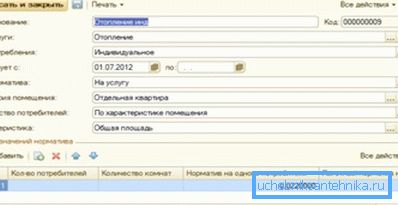
Now let's see how heating is calculated for the general house needs, if the control system is not installed, and there is no local production (heating of the heat carrier) and hot water supply. In addition, there are no individual devices in any place, and then the calculation of the necessary payment should be made using the formula Pi= Su* NT* TT. (See also the article Individual heating in the apartment: features.)
First you need to establish a standard for the service and for this you can go to the Reference Guide. Here you need to specify the Total area by the Room characteristic, and in our case, for example, you can set the value to 0.022 gigacalories. This value may vary depending on the values of standards approved by regional legislation.
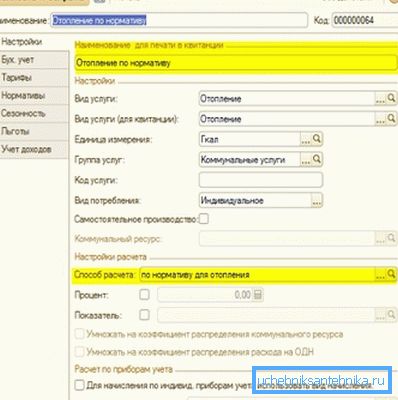
Go to the menu Municipal Accounting / Reference books / Accruals / Types of charges and create a type of charging Service according to the standard, and we will have a calculation method, as indicated in the bottom photo.

This value is set by a square meter, therefore, we need to choose a predestination According to the characteristics of the room, and then predestination according to the characteristics of the Total area.

Go to the appropriate menu in the directory Approval of tariffs Communal Accounting / Documents / Services and indicate the rate that is defined for the area by the regional service. In this case, as an example, we take the value of 1500 rubles per gigakaloriya. (See also the article Electric heating: features.)

Now we are moving to Communal Accounting / Documents / Charges / Utilities Charges. In this example, we have Andrei Andreevich Andreev, who owns a living area of 60m.2, and the tariff of this region is 1500 rubles for one gigacalorie with a value of 0.022 gk / m2, therefore, 60 * 0.022 * 1500 = 1980, that is, for payment we get 1980 rubles.

To form a document for payment, go to the municipal accounting / reports / accruals / payment document. There we will see the accrued amount, which is billed for our subscriber, that is, this is the so-called payment document.
An example of making a payment with CPPU and IPU

Now let's see how to calculate the heating for the general house needs with the installed PDPU, but at the same time also the IMS is installed, and there is no local production (heating of the heat carrier) and hot water supply. For such calculations, use the following formula: Pi= (Vin+Viabout the day* (Si/ Sabout)) * Tto p.
From June 1, 2013, relying on paragraph 40 of the aforementioned Rules, payment is made cumulatively, that is, this instruction provides that services in a residential or non-residential premises are combined with house consumption. To do this, you need to activate (tick) the box Use when calculating consumption for ODN.
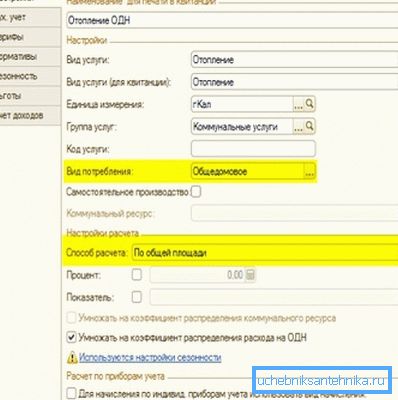
To make a charge for the service we are discussing, you should create a certain type of charge by going to the menu Municipal Accounting / Directories / Charges / Types of charges. For this purpose, in the Type of consumption, we set the value of the Household value, and in the Calculation methods - By Total Area, as shown in the upper image.
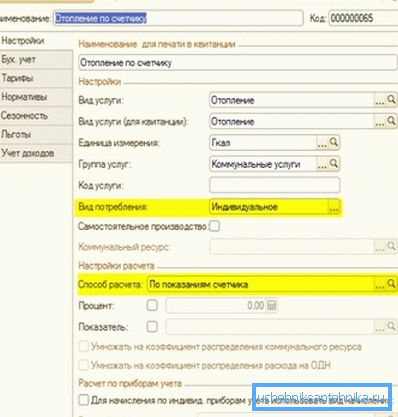
Now we need to specify with our own hands that the calculation will be made, like Heating by the meter, where the indications of the TLI or individual metering device will be used. Here you must specify the type of consumption Individual, when calculating According to the meter readings.
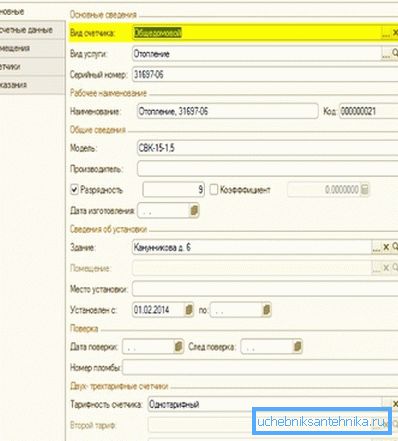

Further, for making calculations, we need to create a general house counter, as shown in the upper image. In the same menu, we also create settings for the ICS.
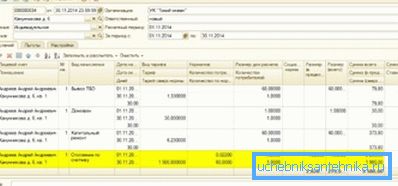
We pass by the municipal account / Documents / Charges / charging utility services, as noted in the upper image.

Now we fill in on this page - we enter data for the data for the current period around the house. We pass through the municipal accounting / Documents / Accruals / Consumption of resources for general house needs.
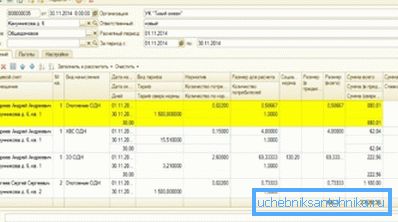
The next and final stage is the cost, that is, here we will already know the price or the amount of the amount that we need to pay for this service. Do not forget that this is possible in the presence of two devices - ОДПУ and ИПУ. In this case, utilities are used / Documents / Accruals / Utilities accrual.
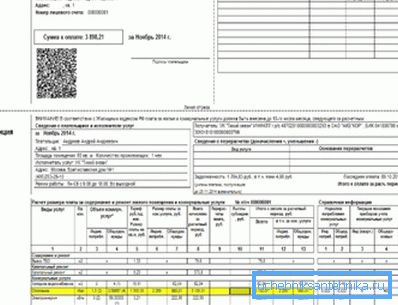
Now it remains only to form the payment, as shown in the upper image, which is filled in accordance with paragraph 3.1 of the aforementioned Rules. There will be a final amount, but this is for the buildings where the TPPUs are installed, and in each apartment there is an IST.
An example of calculations with the established ODPU without the presence of IPP
Note. In this situation, it is possible to make calculations if there is an installed MDPU in the building, and the TLU is absent, but also this method is appropriate if in some residential or non-residential premises the TLU is installed, but not in all apartments, that is only partial availability of ICS.
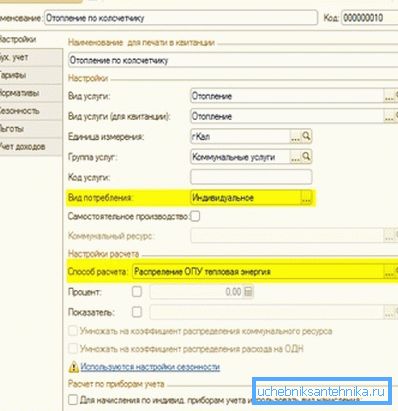
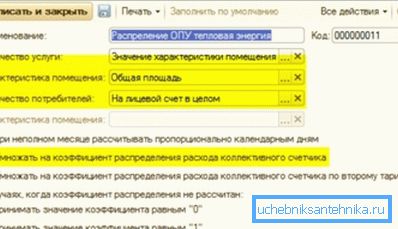
Go to the directory Types of charges, as is done in any cases, and customize the page by value individually, as seen in the top photo. There we indicate the method of calculation using the Value of the characteristic of the room, then indicate the value in the item Total area, and in the number of consumers we need to indicate the personal account as a whole.
In the item Multiply the distribution coefficient of the collective meter flow rate, put a check mark.
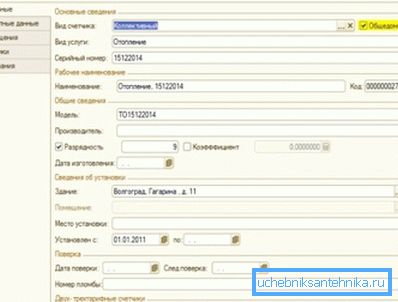
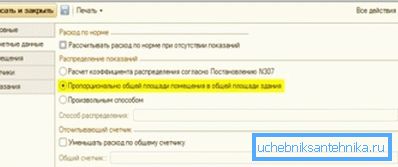
On the reference book known to us, we tick the value of the General House value, that is, here we mean ODPU. After that, in the Calculated data menu, we need to adjust the consumption according to the item Proportional to the total area of the room in the total area of the building.

We go in the menu Accounting for indications of collective counters.

We pass on the accrual of utilities and expose the method of consumption Individual ..
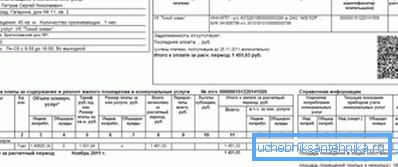
We form the Payment document.
Conclusion
You can see that home heating meters and individual appliances allow you to calculate your share without any problems. But, of course, it is better to have IPU in your living space.